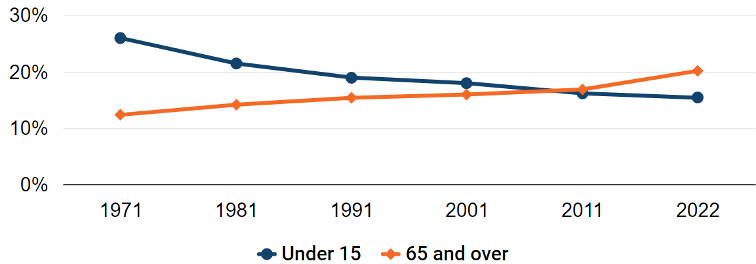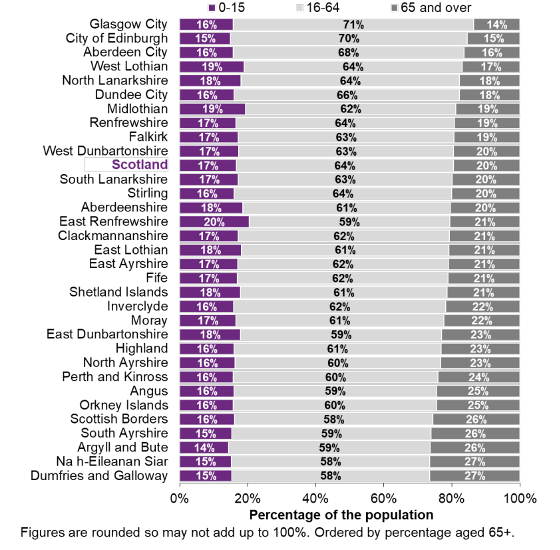Local authorities and fiscal sustainability: the value of evidence
Published: 24 March 2024
In collaboration with the International Public Policy Observatory, the Centre for Public Policy is exploring how local authorities are responding to the challenge of fiscal constraint. This work will pay close attention to how these issues are playing out in the UK’s devolved nations.
In this blog, Professor Graeme Roy and Dr Robert Richardson share more about the work and look at the particular challenges faced by Scotland given its ageing population.
Local authorities across the UK face significant funding pressures brought upon by a combination of tight settlements from central government, a lack of elasticity in their tax base, and growing demand for services.
As Sarah Chaytor highlighted in a recent blog for our partners the International Public Policy Observatory (IPPO), the funding squeeze on local government is likely to bite into key services, many of them crucial to the long-term public service reform.
The Centre for Public Policy is working with IPPO on a new project to explore with local councils how best to respond to the challenge of fiscal constraint. This will include a series of roundtables to gather attitudes on fiscal constraint among local authorities across the UK, and to better understand the common threads that underpin responses to budget cuts. We will be holding our own roundtable on local government fiscal constraint in Scotland, following our policy lab on Scottish Government and local government relations in March.
A focus on devolved nations
We will pay close attention to how these issues are playing out in the UK’s devolved nations. Key issues to be explored include who holds the balance of risk for fiscal sustainability with a devolved setting, and how this impacts upon devolved policymaking. This work will also provide important opportunities for authorities to share practice and understand how others are innovating in response to fiscal constraint.
Whilst much of the focus will – quite rightly – be upon the near term and how local authorities respond to immediate budget pressures this upcoming financial year, it is over the longer term that the greatest risks, but also the opportunities, exist for positive reform.
At the national level, the Office for Budget Responsibility have highlighted the challenges facing the UK public finances over the long-term from issues such as climate change, rising health inequalities, and an ageing population.
One thing that is clear however, is not all these challenges are shared equally across the different nations of the UK or local authorities.
Scotland's ageing population
In Scotland, the Scottish Fiscal Commission has analysed the potential implications of the ageing population – and rising costs of delivering health care services – on devolved services. This analysis projects an average gap of 10% of Scottish Government spending over the next 50 years.
The recent census showed that the average age profile of Scotland’s population continued to increase. There are now over 1 million people in Scotland aged 65 and over, and this is projected to grow in the years to come.
Back in 1971, there were around double the number of children aged under 15 as there were people aged over 65. In 2022, there are now around 250,000 more people aged 65+ than those aged under 15.
Scotland's ageing population

Source: Scotland's Census 2022 - Rounded population estimates | Scotland's Census (figure 2)
All of this will put increased pressure on health budgets, with less resource available for other public services. At the same time, many frontline services to respond to the challenges of an ageing population – including care and community services – are delivered by local authorities.
What is also striking, is the diverse outlook for changing demographics and population structures at a local level.
A shift to the east
In Scotland, a key trend, evident in the early 2000s, but accelerating in the 2010s, has been a shift to the east of the country. Collectively, the local authorities of Edinburgh, Midlothian and East & West Lothian, have seen their populations grow by nearly 70,000 since 2011. To put that in context, that is more than the entire population of the local authority of Clackmannanshire or around 90% of the population of Inverclyde. Other local areas have seen their populations fall. The age profile of local authorities looks different too. Compared to a Scottish average of 20%, in Argyll & Bute, Dumfries & Galloway and the Western Isles around 27% of the population is now aged 65+.
Age structure of population by local authority area

Source: Mid 2021 Population Estimates, Scotland, Report (figure 10, p.20)
Acute pressures
Variations in the future population growth and age profiles will put pressure on public service delivery in different parts of the country. Those areas with an ageing population, will face more acute pressures on health and social care budgets with fewer tax payers contributing to services. In other areas, growing populations will put increased pressure on school, transport, and housing.
Just over ten years ago, a government-led review into the future of public services in Scotland – the Christie Commission - chaired by the former leader of the Scottish Trade Union Congress – warned of these pressures. Christie implored Scotland’s political leaders to focus upon, amongst other principles, a shift to prevention and a bearing down on inefficiencies and lack of integration in service provision.
In our upcoming events at the Centre for Public Policy and IPPO, we’ll no doubt return to such issues and discuss solutions and options for reform. Robust evidence on the resource challenges facing public services will be as important as ever.
Authors
Professor Graeme Roy, Dean of External Engagement and Deputy Head of College, College of Social Sciences, University of Glasgow
Dr Rob Richardson, Research Associate, Centre for Public Policy, University of Glasgow
-
Preview image by Jason Briscoe on Unsplash
Listen: Regional inequalities and inclusive growth
Find out more about the Policy Lab on Scottish Government and local government relations in a recent episode of the University's Spotlight Podcast.
Guests Dr Marianne Sensier, University of Manchester and The Productivity Institute, and Neil Lee, Professor of Economic Geography at the London School of Economics, talk to Professor Graeme Roy and Dr David Waite.

First published: 24 March 2024

